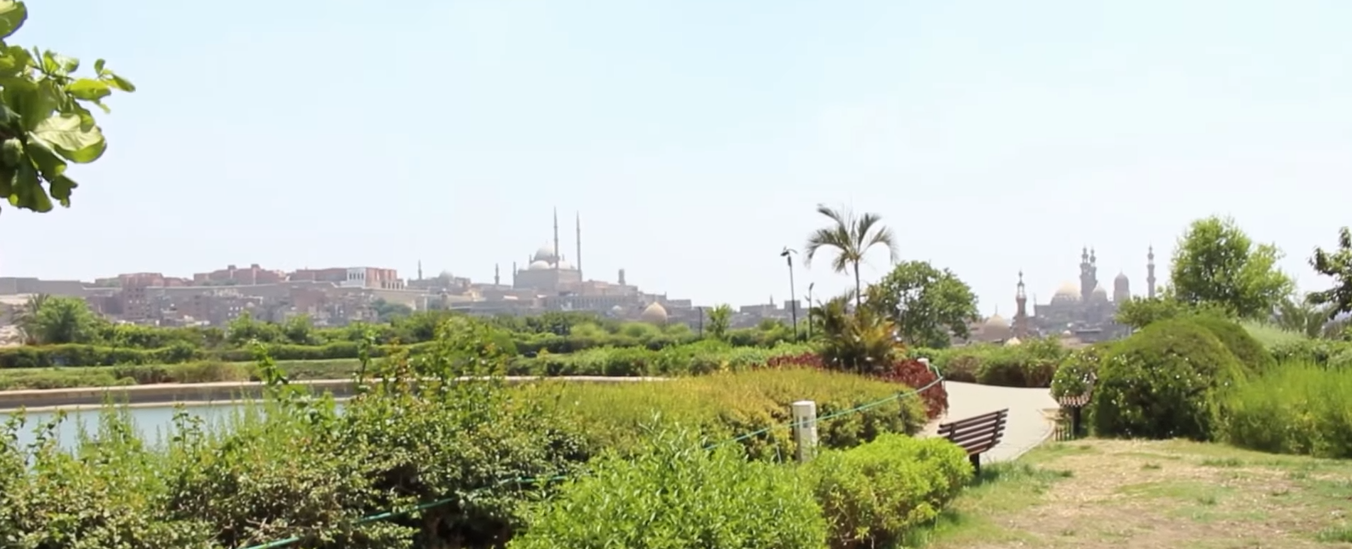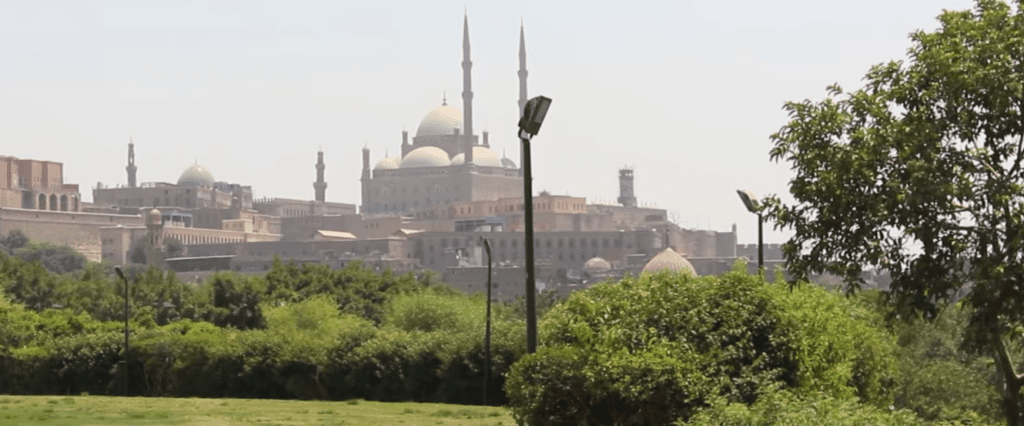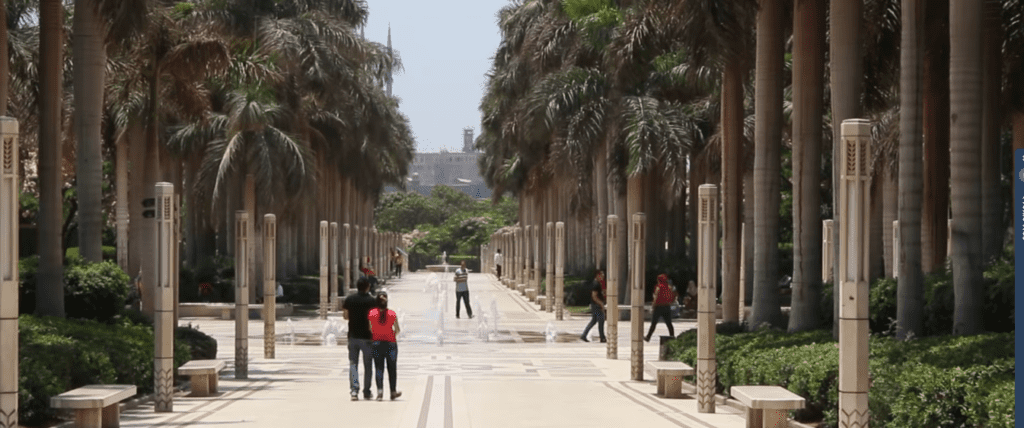Al Azhar Park, A Gigantic Gem in the Heart of Old Cairo

Updated On: April 07, 2024 by Salma Ihab
Because of its essential location, which is Egypt’s capital and the largest of all the provinces, in addition to its historical status, Cairo has excellent prominence among the cities of the Middle East. From ancient Egyptian moving to Roman, Coptic, then Islamic eras, the city has witnessed some of the greatest civilisations around the world whose remains are still standing till the present time.
According to UNESCO, the area of Old Cairo has the lion’s share of Islamic remnants in the world, which is one of the reasons why Cairo earned the name of “the city of a thousand minarets.”
At a time when a significant space in Old Cairo was neglected, poverty and health deterioration were the dominant factors. Opened in 2005 after many years of preparations, a public park named Al Azhar Park was opened in the middle of the grey, forgotten old area to become a reanimation to the whole district around it.
A Historical Journey
The story of Al Azhar Park begins in the late 20th century when His Highness Aga Khan IV, the spiritual leader of the Ismaili Muslim community, envisioned a project that would revitalise the historic heart of Cairo while also providing much-needed green space for its residents. The area where the park now stands was once a neglected and lonely landfill, surrounded by centuries-old monuments and residential neighbourhoods.
In 1984, the Aga Khan Trust for Culture embarked on an ambitious initiative to transform this neglected site into a world-class park celebrating Cairo’s rich cultural heritage and providing a peaceful retreat for its citizens. After years of meticulous planning and restoration, Al Azhar Park was officially opened to the public in 2005, marking a new chapter in the history of Cairo’s urban landscape.
A Botanical Paradise
One of the most striking features of Al Azhar Park is its lush botanical gardens, which showcase a diverse array of plant species from across the globe. As visitors stroll along winding pathways lined with fragrant flowers and towering trees, they are transported to a serene natural environment far removed from the chaos of the city streets.
The park’s landscape architects drew inspiration from traditional Islamic garden design principles, incorporating geometric patterns, water features, and shaded pavilions. These elements enhance the park’s aesthetic appeal and serve practical purposes, providing shade, cooling breezes, and a sense of enclosure.
Barrows of Accumulated Waste
It all started around 70 years ago when Agha Khan IV (49th Imam of the Nizari Islamist and a descendant of the Fatimid Dynasty) decided to donate 30 million dollars to build Al Azhar Park in the heart of the Old Islamic Cairo as a gift to the city that once belonged to his ancestors and was created by them.
So, the perfect spot was chosen between the 12th-century Ayyubid City and the 15th-century Mameluke City of the Dead. In a space of around 75 acres initially loaded with rubbish accumulated for 500 years near El Darrassa, the Historic Cities Support Programme – a part of the Aga Khan Trust for Culture – started to execute the project.
Al Azhar Park and the Restoration of Other Treasures
During the digging process, tons of scrap, waste, and remains were removed to be replaced with beneficial soil around two meters deep, besides the Geotechnical treatment the area has received to ensure everything is suitable and healthy. This wasn’t the only transformation that occurred in the area.
During the process, a whole restoration to the neighbourhood of Darb Al-Ahmar (one of Cairo’s poorest areas where the population have suffered from overpopulation, lack of education, and other severe problems with healthcare and sanitation) has taken place, from housing repair to improving health and hygiene facilities in addition to many job opportunities which were offered at the park. So, mainly, the project of Al Azhar Park has returned with plenty of benefits to the population around it.
The rehabilitation of the Darb Al-Ahmar district wasn’t the only improvement in the area during the creation of Al Azhar Park.
Another significant improvement was made during the excavation when a 15-meters-depth forgotten historical wall that belongs to the Ayyubid era – from the 12th century – was found under the pile of rubbish. That’s when the Ayyubid Wall started to undergo extensive reformation during Al Azhar Park’s construction.
The Islamic Classic Style and The Park’s Design
Though there were some obstacles due to the nature of the soil and the terrain, with some adjustments to the water equipment and the soil and the terrain, the situation improved for them to proceed with the process.
As for the layout, the designers intended to build Al Azhar Park in the classic Islamic style for both design and the choice of gardens, as the surroundings of the whole area also go back to different periods of the Islamic era. Hence, the park will bring a fresh Islamic spirit to the entire district.
Gardens, fountains, vast areas, sitting yards, pathways, and different buildings are constructed in various styles of the other Islamic periods, including the Fatimid, Persian, and Timurid, and the colourful stonework made in the style of the Mamluke period.
As for the sitting yards are mainly designed in the takhtaboush style (design for the public spaces and ground-floor house halls where a person can receive visitors; takhtaboush was famous in Ottoman local architecture). Besides the artistic design, Al Azhar Park is also famous for different kinds of plants, especially those Egyptian-native ones, in addition to what’s known as “bustan-like orchard spaces”.
A Window to the Old Islamic Cairo

Strolling around Al Azhar Park will be pretty much like walking around a 360-view open museum and helps with the hilly nature of the surrounding area.
The park is encompassed by some of the most magnificent structures of Old Islamic Cairo and dozens of old minarets. On its west lies the Fatimid City with its historic buildings, ancient mosques, shrines, madrasas (senior Islamic schools) and the Darb Al-Ahmar district.
In the southern area, both Al Sultan Hassan Mosque, Al Refa’i Mosque and their surroundings are located. The famous Salah El din Citadel, aka Ayyubid Citadel or Cairo Citadel, is also located south of the park with a breathtaking view of Muhammad Ali’s Mosque, especially at night.
As for the eastern side lies the Mameluke “City of the Dead”, aka Cairo Necropolis – a 4-4-mile-long space of dozens of Islamic cemeteries and shrines where living people live among the dead ones.
Reciprocity of Cultures and Arts

Al Genaina Theater is a semi-open theatre located along the Cairo-Ayyubid Wall on the western edge of Al Azhar Park and can accommodate up to 500 spectators. Opened in Al Azhar Park in 2005, Al Genaina Theater aims to present various musical and theatrical programs throughout the year, mainly presented by independent artistic groups and bands from Egypt and the Arab region.
It aims to bring different artistic cultures together in one place and to provide leading and distinctive technical opportunities to help young and rising Arab artists explore different creative horizons.
The theatre has gained wide fame since its opening as one of the most cultural sites aiming at enriching the culture and artistic reality in Cairo and creating a state of musical mobility through the programs, events, and festivals offered by the theatre to the public at affordable prices.
Al Genaina offers around 60 concerts a year during the summer season, which starts in April and ends in November. Arab and international bands and artists perform these concerts through monthly programs. On the other hand, it’s important to mention that the main credit for establishing this cultural tower goes to the Cultural and Local Development Fund of the Dutch Embassy in Cairo.
Food with a Historical Taste
Imagine sitting in the core of an open museum enjoying a pleasant meal or drink. The food experience in Al Azhar Park is unique as it has a taste of history. With a fantastic extensive view of the Ayyubid Citadel lies the Hilltop Restaurant at al Azhar Park.
Two Egyptian architects, Rami El-Dahan and Soheir Farid, designed the restaurant with a touch of Cairo’s conventional architectural style. The restaurant has a small classical fountain at the centre and an elegant shaded space at the end with a lovely terrace where you can see the Citadel.
Besides the Hilltop Restaurant, there is also the Lakeside Cafe (a Lebanese cuisine), designed by Serge Santelli. This award-winning French architect also has a magnificent view of the Citadel.
If you want to treat yourself with nice ice cream, a light meal or snacks, then Alain Le Nôtr is a perfect choice. You can go to Studio Misr for Egyptian food or daily theme buffets.
Museum of Historic Cairo
With the collaboration of the Egyptian Supreme Council of Antiques, The Aga Khan Thrust is working on a new project to build a museum to showcase the development of Islamic Cairo’s history through different eras.
The museum will be constructed at the Northern end of Al Azhar Park. It will be built on 4,000 square meters to display more than 1,000 items to be exhibited from various periods of Cairo’s history and its evolution throughout time.
The museum will contain a unique laboratory to help recondition essential elements from the Cairo Museum of Islamic Art and teach young workers to deal with and preserve such valuable pieces.
In addition to being a huge turning point in the lives of the surrounding districts, the park now attracts millions of visitors every year, from families who are looking to spend some quality time together and get some fresh air to those who are interested in discovering the secrets of history, culture, and art.
With all of this in one place, Al Azhar Park can be considered a bridge that connects different cultures and interests and brings the past to the present.
Have you ever visited the Al Azhar Park in Cairo, Egypt? Let us know your experience in the comments below.
More Amazing Cairo Blogs: Cairo’s Orman Gardens | Downtown Cairo – History and Architecture | Cairo Citadel | Places to Visit in Cairo






